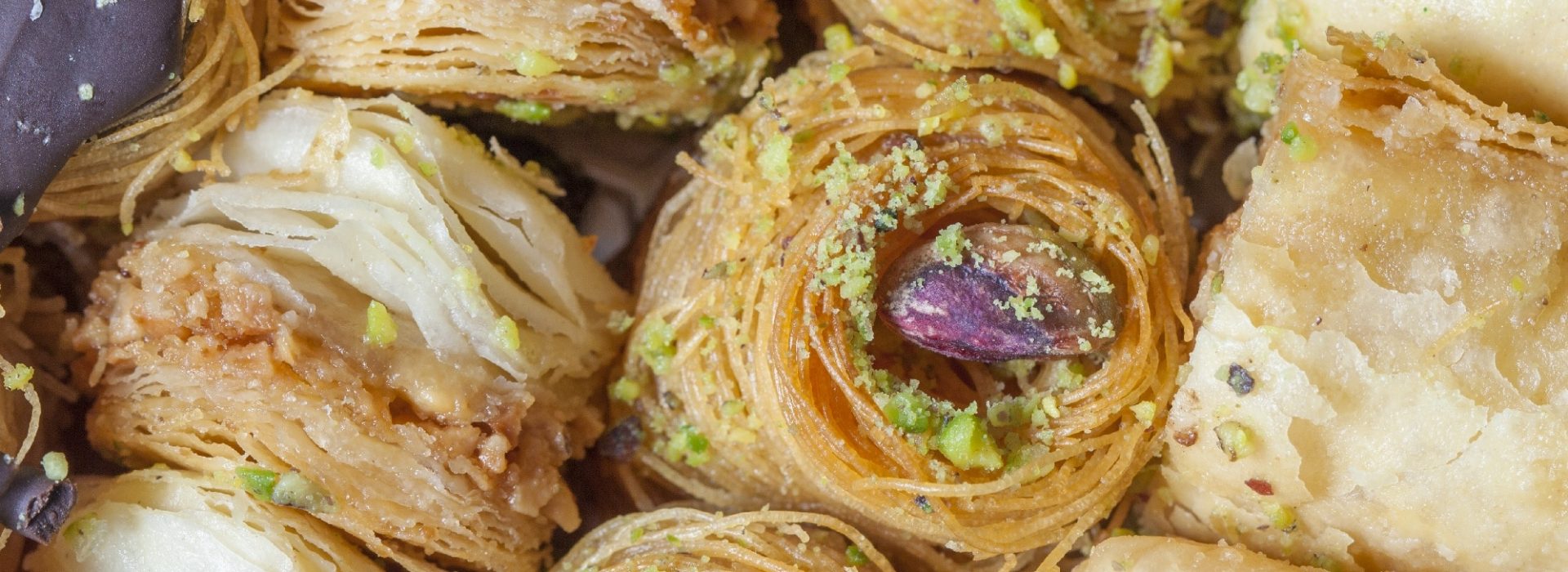Baklava Dessert: The Most Famous Middle Eastern Dessert
If baklava dessert makes you weak at the knees, this is for you. Dedicated to all the baklava lovers out there, get ready to meet your new favourite holiday place. It is a filo pastry stuffed with nuts and drenched with delicious syrup or honey. Some opt for rose water for that extra kick of aroma. You will find this front and centre at any Middle Eastern bakery. They taste just as delicious as how they look! Earthy and nutty, this is a dessert that you must have.
Origin of the Baklava Dessert?
Who invented the Baklava? This can be a topic of hot debate. The Greeks and Turkish will argue over the ownership of this amazing dessert. But, the truth is the Byzantine (or Eastern Roman) Empire heavily influenced both cuisines. So, with that out of the way we can look at the food itself. Today, we’ll explore some variations of the popular pastry. We’ll also show you where you can find them!
Baklava is made from layers of filo pastry that are filled with nuts and sweet syrup. Once baked, we coat them in more syrup or honey. Finally, we top them with finely chopped nuts for extra crunch. Either cut into triangles or diamonds, sometimes they feature just one nut type. Other times they contain multiple nuts. Generally, the regional variations are as follows:
- Afghanistan: crushed pistachios on top
- Armenia: (called paklava) cinnamon and cloves
- Azerbaijan: (also called paklava) covered with almonds or walnuts
- Albania: filled with walnuts, the dough sometimes includes egg yolks
- Black Sea: hazelnuts
- Bosnia: walnuts and cloves
- Bulgaria: walnuts and honey syrup, sometimes pistachio
- Cyprus: covered in crushed pistachios
- Egypt: walnuts and sugar syrup
- Greece: almonds or walnuts, plus honey and cinnamon
- Iran: smaller and drier, with rose water
- Israel: pistachios, walnuts, hazelnuts, and almonds, plus sweet butter, sugar, cinnamon, and citrus syrup
- Jordan: pistachios plus sugar or honey syrup
- Lebanon: pistachios, walnuts, cashews, pine nuts, and almonds, with orange blossom, rosewater syrup, or lemon juice
- Syria: butter, walnuts, and sugar syrup
- And finally, Turkey: pistachios, walnuts, almonds, and kaymak (a type of cream)
The Famous Antep Baklava
Special mention goes out to Gaziantep, a city in Turkey famous for its pistachio baklava. Introduced to Gaziantep by Damascus in 1871, a geographical indication for Antep Baklava was even registered with Turkey’s patent institute! Think Champagne and the northeast region of France. Additionally, in Gaziantep, they use only locally grown pistachios and no added ingredients like cinnamon or rosewater that are sometimes present in other regional versions.
However, you don’t have to travel all the way to Gaziantep to find delicious baklava dessert. Unfortunately, until we can go to Turkey and taste the Antep Baklava for ourselves, let our dessert repository show you where to find locally made baklava pastry that’s deliciously sticky from honey and syrup.
Now, while we’re at it, let’s take a look at a few common pastries that are made primarily with pistachio:
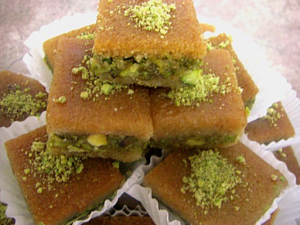
Basma Pistachio (Malak Pastry)
- Basma Pistachio: A semolina-based baklava filled with a generous layer of chopped pistachios. The semolina dough (or knafeh dough) on the top and at the bottom create a sandwich-like dessert. The dessert is drizzled with a sugary sauce. This dessert originated from the Levant area (i.e., Lebanon, Syria, & Palestine). Basma means “a smile” in Arabic. This baklava dessert will definitely bring a smile to whoever chooses to eat it.
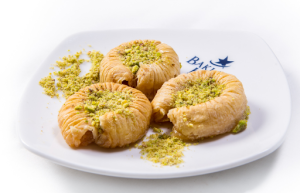
Swar (Baklava King)
- Swar Al Sit: This flaky ring-shaped filo(Phyllo) dough surrounds finely-grounded pistachios. This dessert is sprinkled with sugary sauce. One bite into this crispy and buttery dessert may leave you with a taste for more.
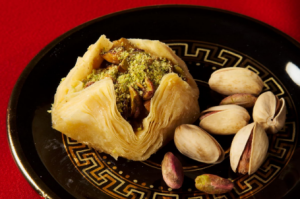
Wardeh (Patisserie Royale)
- Wardeh: Another filo-based baklava in the shape of a rose flower. The center is filled with whole pistachios, while the fine phyllo edges serve as gentle flower petals and hold these precious sweet pistachio nuts inside. In Lebanon, it is also called Bukaj baklava.

Crispy and chunky Balaurieh Pistachio (Crown Pastries)
- Balaurieh Pistachio: Similar to the Basma, this two-layered baklava dessert consists of crispy phyllo strings on the top and the bottom, filled with pistachio and soaked in syrup.
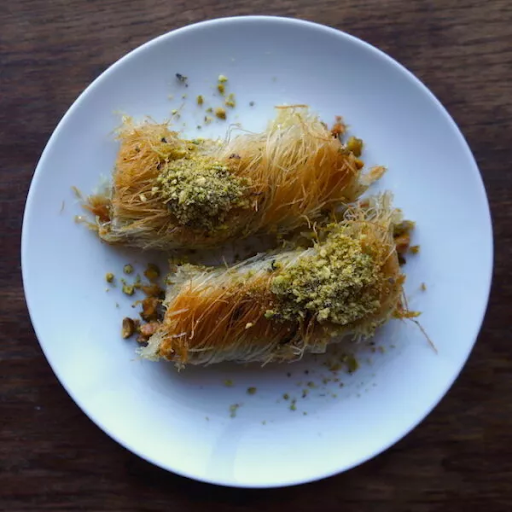
Burma kadayik is a type of baklava (Vegan Middle East)
- Borma/Burma kadayıf: This Turkish dessert made with kadayıf (buttery, shredded filo dough) that wraps around pistachios. This kind of baklava can also be made with walnuts. These rolls are commonly cut into small pieces.
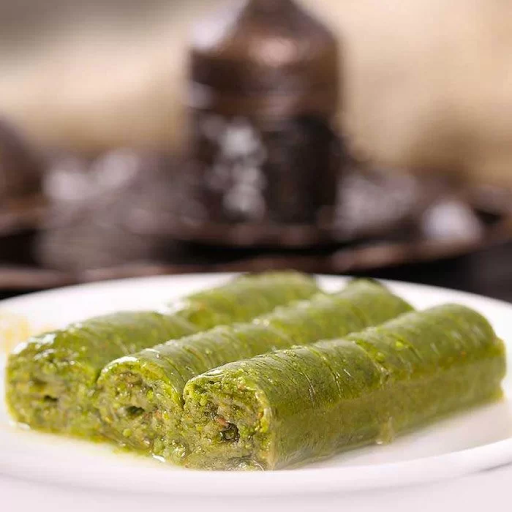
Fıstıklı Sarma filled with pistachio butter (Stamboul Bazaar)
- Fıstıklı sarma or fıstıklı dürüm: The name of this baklava translates to pistachio wrap or pistachio roll. The filling for this dessert is very similar to marzipan. It is made with pistachio butter (also called fıstık ezmesi). The filling is gently wrapped around the filo dough.
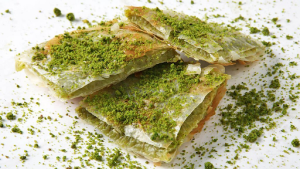
Katmer is a honeymoon tradition (Turkish Foodie)
- Katmer: is a specialty from Gaziantep(Turkey) and many locals eat this treat for breakfast. It is also a tradition for newlyweds to consume this delicacy after their wedding night as a way to wish for sweetness in their marriage.The main ingredients for Katmer are pistachios, flour, salt, sesame seeds, and kaymak (a dairy food that is similar to clotted cream).
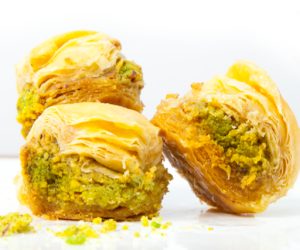
Kol w Shkor pistachios baklava (Délices des Cèdres)
- Kol w Shkor pistachios: This sweet is made of fine layers of light crispy phyllo dough. It is filled in the middle with pistachios and sweetened with a sugary sauce. The contrast between the golden colour of the dough with the green pistachios makes it scrumptiously attractive.
Baklava dessert is the stuff of dreams, and pistachio desserts as well. Why not combine the two? To find all the best treats near you, head to Dessert Advisor.
